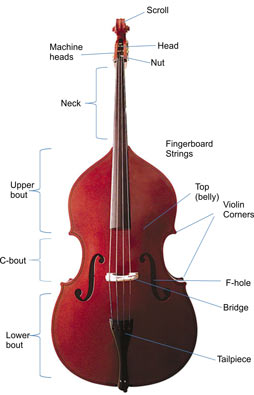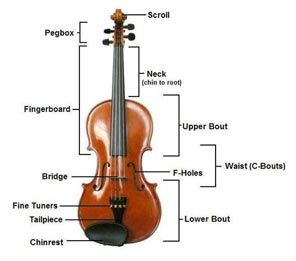
Storage
Avoid excessive heat, cold, dryness, and humidity. Keep the instrument indoors (never leave it in a car on a hot day). To avoid cracks resulting from particularly dry weather, you can keep a wet paper towel in a punctured plastic bag in the instrument case to act as a humidifier, or you can use a DampIt, which we sell online and in the shop.
Don’t leave your violin or viola on a chair, and don’t leave your cello or bass leaning against a wall. Also never leave your violin or viola in its case with the lid closed but the zipper/latches open; it’s too easy to forget and have the instrument fall out. Violins and violas should be closed securely in their cases, and cellos and basses should be placed in a stand or on their sides on the floor. For cellos and basses, put the endpin as far into the instrument as possible when you’re done playing, to minimize the likelihood of kicking or tripping over it.
Pick up cellos and basses by the C-bout corner, not with the f-holes.
With violins and violas, remove your mute and shoulder rest before placing the instrument back in its case.
Loosen your bow’s tension after playing. Otherwise, it can warp or break over time.
Wipe off the strings and the stick of your bow with a soft, dry cloth after playing. Otherwise, rosin will build up and degrade the resonance of the strings, and it will leave residue. Try not to apply too much rosin; you only need to apply more when the bow is not adequately pulling the strings.
If you want to polish your instrument, use an appropriate polish and follow the instructions carefully. Never use furniture polish or alcohol, which will strip off the varnish. Please do not attempt to fix damaged varnish yourself.
Maintenance
Strings should be changed every six months for daily players, or yearly for occasional players. New strings may need an hour or two of playing time to break in.
When changing strings, do so one at a time. The bridge is not glued onto your instrument, but rather held in place by tension, so loosening all the strings at once will cause the bridge to fall, and possibly cause the soundpost to fall inside the instrument’s body. The placement of the bridge and soundpost are very important, so be sure to let one of our luthiers or someone with the proper training adjust these items for you.
If you notice a crack or an open seam, don’t try to glue it yourself. Cracks should be repaired by one of our luthiers as soon as possible to minimize damage. Likewise, if you hear a buzz when you play or if you notice anything else out of sorts, please bring it into the shop.
Particularly with violins and violas, hold the instrument by the neck rather than by the fragile scroll, and avoid touching varnished surfaces with fingers.
Avoid touching the bow hair with your fingers.
Don’t yank a broken hair out of your bow, which can loosen more hairs or pull them all out. Trim loose hairs with scissors or nail clippers.
New rosin needs to be “started” in order for it to be applied to your bow. You can do this by scratching the surface of the new rosin with a key, sandpaper, or the like.
Have fun!
Remember: playing a little every day is better than playing a lot just before a lesson or performance.


